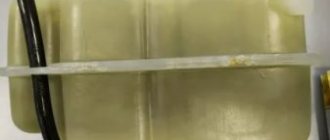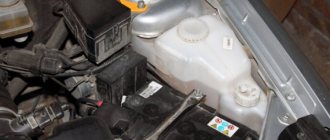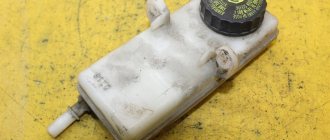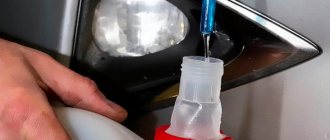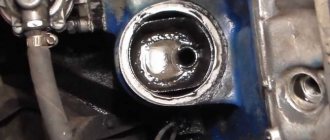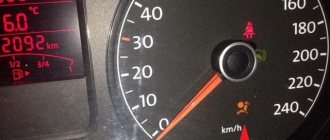Home » VAZ repair
1 minute to read. Updated 08/04/2019
1200 rub. for the photo report
We pay for photo reports on car repairs. Earnings from 10,000 rubles/month.
Write:
A breakdown of the cylinder head gasket leads to such unpleasant consequences as engine overheating, poor operation of the stove, the appearance of exhaust gases from under the hood of the car, the appearance of an emulsion in the engine oil, the appearance of white smoke from the exhaust pipe and some others. If the above symptoms or one of them appear, you need to check the cylinder head gasket. There are several ways to do this. Next, we will look at why the cylinder head gasket breaks, what consequences this leads to, and what to do if this trouble happens to your car’s engine.
Signs that the cylinder head gasket has blown
The purpose of the cylinder head gasket is to ensure tightness and prevent gases from penetrating from the cylinders back up into the engine compartment, as well as mixing coolant, engine oil and fuel with each other. In a situation where the cylinder head gasket is punctured, the seal of the block is compromised. The following signs will tell the car owner about this:
Signs of a burnt cylinder head gasket
- Exhaust gases coming out from under the cylinder head . This is the simplest and most obvious sign. When the gasket burns out, it begins to let in exhaust gases that will escape into the engine compartment. This will be visible visually, as well as audibly - loud sounds will be heard from under the hood that are simply impossible not to notice. However, if the burnout is small, then you need to pay attention to other signs.
- Shot between cylinders . External signs will resemble those that occur when the engine “troubles.” The fuel mixture from one cylinder is mixed with exhaust gases in the other. As a rule, in this case it is difficult to start the engine, but after warming up it continues to run steadily. To determine the breakdown, it is necessary to measure the compression of the cylinders. If the mentioned mixing occurs, the compression value in different cylinders will differ significantly.
Emulsion from under the expansion tank cap
Foam in the expansion tank
A clear sign of engine overheating is the presence of condensation on its surface. This is also an indirect sign of a burnt-out cylinder head gasket or a crack in the cylinder block. First of all, it is necessary to conduct computer diagnostics of the engine. The presence of errors will indicate the direction and possible additional faults. As a rule, these errors are associated with problems in the ignition system.
Antifreeze in the cylinder
Let's look again at mixing antifreeze and oil. As mentioned above, as a result of mixing them, an emulsion of a yellowish (most often) color is formed. If it appears, then simply replacing the cylinder head gasket will not be enough to repair. It is imperative to flush the system of this composition. Including pan and oil channels. And this may cost you additional costs, sometimes comparable to a major engine overhaul.
We have dealt with the symptoms that occur when the cylinder head gasket is broken. Next, let's move on to considering the reasons why its burnout can occur.
Let's sum it up
As you can see, having examined a number of reasons for the boiling of antifreeze or antifreeze in the expansion tank, we can conclude that it is quite possible to diagnose them, often even independently.
It is important to understand that the cooling system of an internal combustion engine plays a primary role in the design of a car. If defects and malfunctions appear in this case, the operation of the engine may be disrupted, and serious damage to the internal combustion engine is also likely.
An important element is the working fluid of the cooling system . The operation of the entire system directly depends on its quality and properties. If you allow the antifreeze in the engine to overheat, it will boil, which will lead to further overheating of the engine. At the same time, detecting a problem in the cooling system and quickly stopping the engine will mean that the power unit will most likely not be damaged.
If, after the antifreeze boils, the car is driven for 10-15 minutes , deformations and breakdowns will occur in the engine, which in many cases becomes the cause of expensive repairs. If the engine overheats too much, it may seize. In such cases, often the only solution is to replace the motor with a contract unit.
It turns out that the need for regular technical inspection of the car engine and its systems is quite obvious. Regular leak testing is recommended, and the selection of high-quality antifreeze is also important. This approach in practice minimizes the likelihood of radiator clogging and pump breakdowns, and high-quality cooling of the unit in any conditions and different operating modes will preserve and increase the life of the internal combustion engine.
Why does the cylinder head gasket break?
In most cases, the reason why problems arise with the cylinder head gasket is simple overheating . Because of it, the block cover may “lead”, and the plane along which the gasket adheres to two contacting surfaces will be disrupted. As a result, depressurization of the internal cavity occurs with all the ensuing consequences. It is mainly aluminum heads that change their geometry. Cast iron is not subject to such malfunctions; they are more likely to crack than to bend, and only in the most extreme cases.
Scheme for pulling cylinder head bolts on VAZ “classics”
Also, due to overheating, the gasket can heat up to temperatures at which it changes its geometry. Naturally, in this case depressurization will also occur. This is especially true for iron-asbestos gaskets.
Another reason is a violation of the bolt tightening torque . Both very large and small torque values have a detrimental effect. In the first case, the gasket may collapse, especially if it is made of low-quality materials. And in the second, exhaust gases pass out without obstructing them. In this case, gases together with atmospheric air will have a detrimental effect on the gasket material, gradually destroying it. Ideally, the bolts should be tightened using a dynamometer that shows the torque value; in addition, the sequence of their tightening should be observed. Help information about this can be found in the manual.
How to find out if the cylinder head gasket is blown
You can determine whether the cylinder head gasket is blown by using one of several methods. In this case, diagnostics are simple and can be done by anyone, even a novice and inexperienced driver.
To check the integrity of the gasket, you must do one of the following:
- With the engine running, visually inspect whether smoke is coming from the gap between the cylinder head and the cylinder head . Also listen to see if there are loud ringing sounds coming from there that were not there before.
- Inspect the surfaces of the radiator caps and expansion tank of the cooling system, as well as the neck for filling oil into the engine. To do this, you just need to unscrew them and visually inspect them. If antifreeze gets into the engine, there will be a reddish emulsion on the oil filler cap. If oil gets into the antifreeze, then there will be oily deposits on the radiator or expansion tank caps.
White smoke from the exhaust pipe
How to check a cylinder head gasket using a condom
One of the effective and popular testing methods is the method using a balloon or a condom. It is put on the neck of the expansion tank, having first unscrewed the cap. The main thing is that the condom sits tightly on the neck and provides a tight seal (instead of a condom, you can use a bag or a balloon, but the diameter of the condom is usually ideal for the neck of the tank). After you put it on the reservoir, you need to start the engine and let it run for a few minutes at 3.5 thousand rpm. Depending on the level of depressurization, the condom will fill with gases quickly or slowly. It depends on the specific situation. In any case, if it begins to fill with exhaust gases, this means that the cylinder head gasket is broken.
VAZ 2101 4 doors sedan, 64 hp, manual transmission, 1970 – 1988 — gases go into the expansion tank
contents .. 1054 1055 1056 ..Bubbles enter the expansion tank (gases accumulate): causes and possible malfunctions
Malfunctions
| Elimination | |
| — the cylinder head gasket is broken or burned out | — replace the cylinder head gasket |
| - cylinder head is faulty | — it is necessary to check at a car service center for cracks or manufacturing defects |
| — the cylinder head was deformed due to engine overheating | — repair or replace the cylinder head |
| - the expansion tank cap is faulty | — repair or replace the expansion tank cap |
| — overheating and warping of the surface of the cylinder head block itself | - check the surface of the cylinder head block |
| — the engine cooling jacket channel is clogged | — clean the engine cooling jacket channel |
| — no circulation of antifreeze (antifreeze), due to local stagnation or pump failure | — repair the pump, eliminate stagnation |
| - the thermostat is faulty | - replace the thermostat |
| — the radiator is clogged, or there is antifreeze on the outside, deposits or build-ups around the cooling system holes | - clean the radiator |
| — the pump is faulty (the pump blades have lost their functionality) | - repair or replace the pump |
| — there is an air lock in the cooling system | - remove air lock |
| - Radiator cap is faulty | - repair or replace the radiator cap |
| — the radiator is faulty (the radiator is not sealed) | - check the radiator for leaks |
| - crankcase gases enter the cooling system | — check the cooling system for leaks |
| - carbon dioxide enters the cooling system | It is necessary to measure the CO2 level in the cooling tank at a car service center |
| - crack in the filler neck of the expansion tank | — check (or replace) the neck of the expansion tank |
Specifications
Technical characteristics of the VAZ 2101 in a 4-door body. sedan with a 64 hp engine, manual transmission, produced from 1970 to 1988.
Basic data
- Start of production:
January 1970 - End of production:
January 1983
- Body:
4 doors sedan
Engine
- Fuel grade: AI-92
- Engine capacity, cubic meters see: 1198
- Supercharging: no
- Power, hp: 64
- Achieved at vol. per minute: 5600
- Torque, Nm/rev. per minute: 89 / 3400
- Maximum speed, km/h: 140
- Acceleration time to 100 km/h, sec.: 22
- Fuel consumption (combined cycle), l. per 100 km: 8
- Fuel consumption (in the city), l. per 100 km: 9.4
- Fuel consumption (outside the city), l. per 100 km: 6.9
Drive unit
- Drive type: Rear
Transmission
- Transmission: Manual
Suspension
- Front: Double wishbone
- Rear: Coil spring
Brakes
- Front: Disc
- Rear: Drum
Dimensions
- Length, mm: 4073
- Width, mm: 1611
- Height, mm: 1440
- Wheelbase, mm: 2424
- Front wheel track, mm: 1349
- Rear wheel track, mm: 1305
- Ground clearance, mm: 170
Other
- Number of seats: 5
- Tire size: 155 SR13
- Curb weight, kg: 955
contents .. 1054 1055 1056 ..
What to do if the cylinder head gasket is blown
Many drivers are interested in the question: is it possible to drive with a broken cylinder head gasket ? The answer is simple - it is possible, but not advisable, and only for short distances, in particular, to a garage or car service for repair work. Otherwise, the consequences of a blown cylinder head gasket can be very dire.
If, as a result of the diagnostics, it turns out that the gasket has broken, then nothing can be done about it except to replace it. It is also worth inspecting the adjacent surfaces, and most importantly, try to find out the true cause of the burnout... The price of the gasket can be different and depends on the brand of the car and the manufacturer of the spare part itself. However, compared to other nodes it is low. Repair work may cost you a little more than simply buying a gasket. The point is that the following points must be taken into account:
- If during the process of dismantling the cylinder head it is discovered that the mounting bolts have become loose and do not meet the technical parameters, they will need to be replaced. And sometimes situations happen when, due to a change in the geometry of the cylinder head, the bolt cannot be unscrewed, and you simply have to tear it off. There is appropriate equipment to carry out this unpleasant procedure. Often modern engines are equipped with bolts that operate at their yield limit. This means that after removing the cylinder head (to replace the gasket or for other reasons), it is necessary to buy and install similar new ones.
- If the plane of the cylinder head is damaged, it will be necessary to grind it. To do this, they use special machines, the work of which will also cost money. However, the working plane of the cylinder head “leads” not so often, but it is still worth checking this parameter. If the surface has been ground, a new gasket must be purchased, taking into account the thickness of the removed metal layer.
Before replacing the gasket yourself, you must clean the head of carbon deposits, scale and pieces of the old gasket. Next, you need to inspect its surface. To do this, use a special measuring tool, usually a ruler. It is passed along the surface, revealing the presence of gaps. The size of the gaps should not be more than 0.5. 1 mm . Otherwise, the surface of the head must be sanded or completely replaced with a new one. Instead of a ruler, you can use a thick sheet of glass (for example, 5 mm thick). It is placed on top of the surface of the head and looked for for possible air spots. To do this, you can lightly lubricate the surface of the head with oil.
Checking the cylinder head surface
When replacing the gasket, it is recommended to lubricate its surface with graphite lubricant. This way it will become softer and easier to find “its” place on the surface of the cylinder head. In addition, it will be easier to remove when dismantling. The advantage of graphite lubricant in this case is that graphite is not squeezed out during operation, turning into ash.
After repair work, the car owner must monitor the behavior of the engine. Do the malfunctions described above reappear (white smoke from the exhaust pipe, emulsion or greasy spots in the coolant, oil at the junction of the cylinder head and cylinder head, no engine overheating, and so on). Moreover, immediately after replacement, you should not operate the engine at maximum power. It is better for the gasket to “settle” and take its place.
Cylinder head gasket failure
A blown cylinder head gasket is a serious car problem that can happen to absolutely any engine. In engines with an aluminum head, this most often happens due to overheating: under the influence of high temperature, the cover loses its working position and depressurization occurs. The second most common cause is improper tightening of the cover bolts.
Third - banal wear and tear, the gasket, like everything, has its own service life. The result is the same - change the gasket, as well as provide high-quality cleaning of the cylinder-piston group, cooling and lubrication systems of the engine. This is important, because due to a breakdown of the gasket, antifreeze leaks into the CPG and oil, and through contaminants into the cooling pipes. If they are not cleaned, serious repairs are not far off.
But let's sort it out in order.
Cylinder head gasket value
The cylinder head gasket is located between the block itself and its head, or in other words, the cover. It performs a number of important functions. Firstly, it ensures the tightness of the block. Secondly, it makes it possible for the gas-air mixture to flow only into the combustion chamber, that is, in one direction. Thirdly, it delimits and promotes the circulation of coolant, fuel and oil. All these functions are vital for the normal operation of the internal combustion engine.
Signs of a cylinder head gasket failure
A cylinder head gasket failure is usually suspected by symptoms such as white smoke from the exhaust pipe, engine overheating, and interruptions in the operation of the stove. You can make sure that the problem is in the gasket without complex diagnostics. The easiest way is to open the hood, start the car and see if exhaust gases are escaping from the engine. This is noticeable visually. Plus, gas breakthrough is usually accompanied by popping sounds.
But this method is only good if the burnout or breakthrough is located along the outer contour and is of significant size . Oil leakage outward from under the cylinder head is not an unambiguous sign of a gasket failure along the edge, but it may also indicate it. In any case, drips in the area where the head and block meet are a reason to urgently go to a service center.
